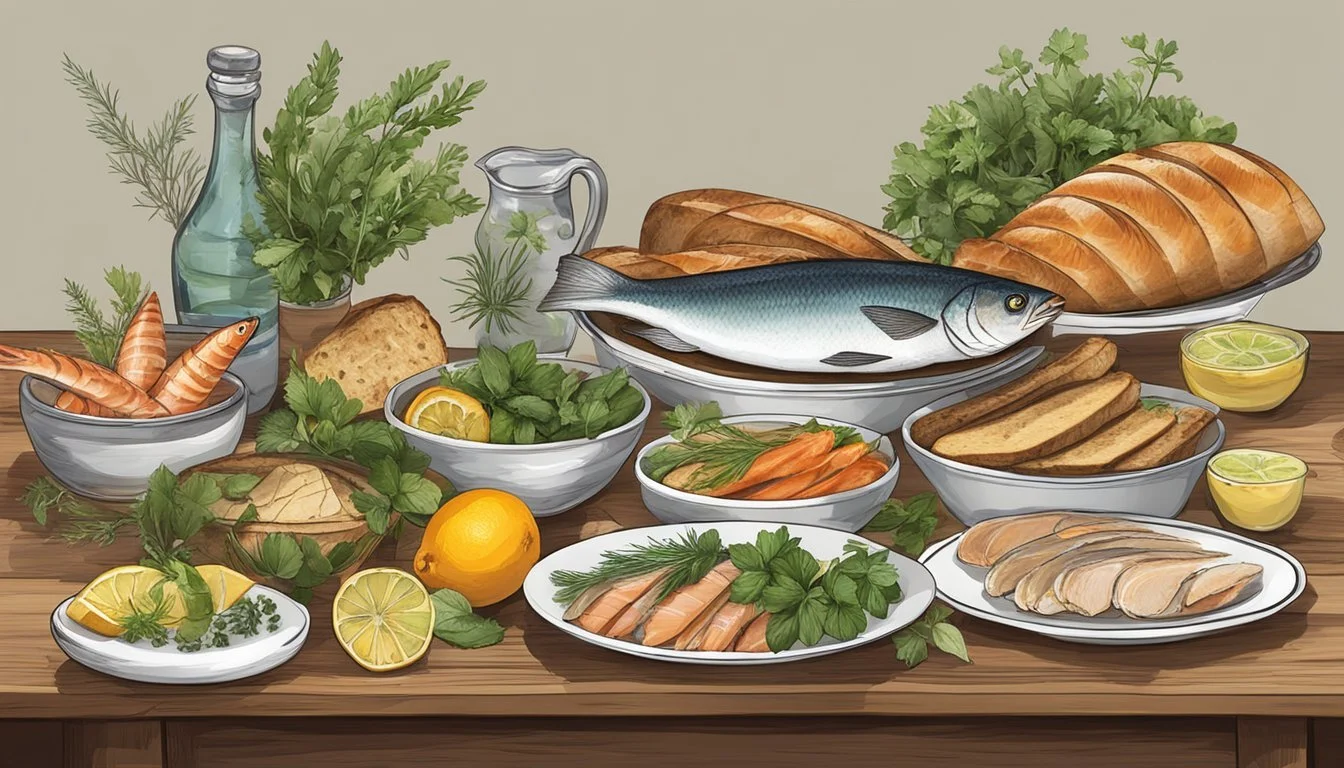Smoked Fish
A Fresh Take on Easter BBQ Traditions
Easter celebrations often conjure images of pastel colors, chocolate eggs, and a traditional ham centerpiece. Yet, a culinary trend which has been garnering attention is the inclusion of smoked fish in the festive feast. The technique of smoking imparts a robust flavor and tender texture to the fish (What wine goes well with fish?), elevating it to a dish worthy of any holiday table. As more individuals explore alternatives to the usual meats, smoked fish offers a delightful variation that integrates seamlessly with Easter traditions.
Smoked fish can be an enticing addition, whether it's served as an appetizer or the main course. Opting for fish brings a lighter option for guests who may be looking for alternatives to heavier meats without compromising on a rich, savory experience. Species such as trout, arctic char, and even lamb shoulder can be excellent choices for smoking. They are versatile in flavor and can be paired with diverse seasonings to match the fresh onset of spring. While the delicate process requires careful attention to timing and temperature, the result is an aromatic dish with layers of complexity that promise to be a memorable part of the Easter menu.
Implementing smoked fish into the Easter BBQ lineup is not only a nod to contemporary tastes but also a gesture of inclusivity for those with dietary preferences such as pescatarians. It's a fresh take that maintains the communal spirit of the occasion while introducing a novel element to the gastronomic landscape of the holiday. With proper technique, the right selection of wood, and an appreciation for the craft of smoking, hosts can offer their guests a unique and satisfying dining experience.
The Tradition of Smoked Fish at Easter
Easter celebrations often incorporate various food traditions that have deep roots in history and culture. One such tradition is the inclusion of smoked fish in the Easter meal, particularly in barbecue (What wine goes well with barbecue?) form.
Why Smoked Fish at Easter?
During Lent, many Christians abstain from eating meat on Fridays, a practice that leads up to Easter Sunday. Fish has long been considered an acceptable alternative, and smoking is a method that imparts rich flavor and preserves the fish, which aligns with the springtime spirit of renewal.
How it's Served
In many households, smoked fish serves as both an appetizer and a main dish. It can be offered as a standalone delicacy or incorporated into more complex dishes, such as fish pies, which are enjoyed in several regions as a comforting Easter meal.
Common Smoked Fish Types:
Salmon (What wine goes well with salmon?)
Trout
Whitefish
Smoked Fish and Easter BBQ
Barbecue, a cooking style known for its communal and festive nature, is a preferred method for many during Easter to enjoy the outdoors and gather with family and friends. Smoked fish easily fits into this setting. Smokers or BBQ grills can be used to both smoke the fish and prepare it for the celebration, offering a fresh take on traditional Easter barbecue.
Cultural Variations
Different cultures add their unique twists to this tradition:
In Britain, a popular dish is the fish pie, often made with smoked salmon.
In Japanese celebrations, dishes such as chirashi-zushi, which can include smoked fish, are common at holiday gatherings.
Overall, smoked fish is a versatile element that enriches Easter dining, bridging the gap between tradition and modern barbecue techniques.
Selecting the Best Fish for Smoking
When planning a BBQ, especially for occasions like Easter, choosing the right type of fish is crucial for a perfect smoked dish. The selected fish should have a high fat content for flavor, a texture that holds up to smoking, and be amenable to the preparations necessary for the best results.
Advantages of Fatty Fish
Fatty fish are generally preferred for smoking due to their high oil content which helps retain moisture through the cooking process. Salmon, with its rich and buttery taste, stands out as a top choice. Other fatty fish suitable for smoking include mackerel, with its pronounced flavor profile, and herring, known for its traditional use in smoked seafood dishes. (What wine goes well with seafood dishes?)
Choosing Fish Based on Texture
The texture of the fish is another vital consideration. A firmer texture ensures the fish holds its shape and doesn't fall apart during the smoking process. Fish like tuna (What wine goes well with tuna?) and swordfish boast a dense texture akin to red meat that works exceptionally well. Others, such as cod or even catfish, present a flaky yet firm texture when smoked.
Popular Fish Varieties
Considering the vast variety of fish, here are some optimal choices for smoking:
Salmon: Offers a rich, silky texture and a versatile flavor that pairs well with numerous seasonings.
Sea bass: Known for its mild, sweet, and delicate flavor and high-fat content.
Trout: Similar to salmon in fat content but milder in taste, making it a favorite for those preferring a gentler smoky flavor.
Halibut: Its lean nature makes it less commonly smoked, yet still a delicious option when done correctly.
Mahi-Mahi: Although not as fatty, it has a firm texture that holds up well in a smoker.
Red snapper: A whitefish option noted for its firm texture and nutty flavor.
Fish Preparation Tips
Proper preparation of fish enhances the smoking process. For instance, brining can help stabilize the meat's structure and improve moisture retention. Key suggestions include:
Ensure salmon and trout are filleted smoothly to expose an even surface area for smoking.
Mackerel should be cleaned thoroughly and can be brined to accentuate its natural oils.
Sea bass and red snapper have denser meats that require careful deboning.
For fish such as halibut or tuna, ensure steaks are cut uniformly to promote even smoking.
Preparing the Fish for Smoking
Proper preparation of fish is crucial for achieving the perfect smoked flavor and texture. It involves a series of steps: brining, rubbing, and marinating, each designed to enhance taste and moisture content.
Brining Basics
Brining, the process of soaking fish in a saltwater solution, serves two primary purposes: seasoning the fish from within and helping it to retain moisture through the smoking process. A basic wet brine recipe might include kosher salt, dissolved in water, along with brown sugar for a sweet flavor, and a variety of seasonings such as black pepper, garlic, and fresh lemon juice. For dry brines, a mixture of salt, sugar, and seasonings is sprinkled directly onto the fish, drawing out moisture to form a briny surface layer.
1 gallon water
1 cup kosher salt
1/2 cup brown sugar
Seasonings: minced garlic, lemon pepper, fresh herbs (how long do fresh herbs last?)
1/2 cup kosher salt
1/2 cup brown sugar
Seasonings: black pepper, onion powder
Applying Dry Rubs
After brining, dry rubs can be used for additional flavor. A dry rub is a mixture of dried herbs, spices, and seasonings that is rubbed onto the surface of the fish. The essential elements of a dry rub are salt and sugar, complemented with aromatics like garlic powder or smoked paprika. Applying a dry rub creates a savory crust on the fish as it smokes.
Dry Rub Recipe:
1/4 cup brown sugar
2 tablespoons kosher salt
1 tablespoon black pepper
1 tablespoon garlic powder
1 teaspoon lemon pepper
Marinating Techniques
Marinating involves coating the fish in a liquid solution that can add moisture and flavor. Typical marinade bases include olive oil or lemon juice, combined with seasonings like kosher salt, garlic, and herbs. For a rich taste, you could also use garlic butter or sweet ingredients to balance out the smoky flavor. Allow the fish to marinate for several hours, turning occasionally to ensure even flavor distribution.
1/2 cup olive oil or melted garlic butter
1/4 cup fresh lemon juice or white wine
Seasonings: salt, black pepper, dill (how long does dill last?), mustard
Smoking Wood Selection
Selecting the right wood for smoking fish is crucial to enhancing the flavor without overpowering it. This section will guide you through the types of woods and their distinct flavors, along with recommendations for pairing specific woods with different types of fish.
Wood Types and Flavors
The type of smoking wood used significantly impacts the flavor profiles of smoked fish. Various woods contribute different taste nuances, ranging from subtle to robust.
Alder Wood: Imparts a mild, slightly sweet smoke, ideal for fish due to its delicate infusion.
Apple Wood: Known for its light, fruity flavor that adds a subtle sweet note.
Cherry Wood: Offers a mild fruitiness, a touch sweeter than apple, with a hint of tartness.
Hickory: Delivers a strong, smoky flavor, typically reserved for heartier fish.
Maple: Provides a mildly sweet, subtle smoky taste, appropriate for subtle flavor enhancement.
Oak Wood: Known for its medium smoky intensity, it's versatile enough to complement various fish types without dominance.
For a visual summary:
Wood Type Flavor Profile Smoky Intensity Alder Mild, Slightly Sweet Low Apple Light, Fruity, Sweet Low to Medium Cherry Mild Fruity, Slight Tartness Low to Medium Hickory Robust, Bacon-Like High Maple Mildly Sweet, Subtle Smoke Low to Medium Oak Medium Smoke, Balanced Medium
The choice of wood chips or cedar planks also factors in the intensity of the smoke and ease of use. Wood chips are commonly used for their quick combustion and compatibility with most smokers, while cedar planks are perfect for a gentler infusion and traditional presentation.
Matching Wood with Fish
Pairing the right wood with the right fish enhances the natural flavors while introducing a pleasant smokiness.
For delicate fish like trout or whitefish, alder wood or applewood chips are an excellent choice to maintain the fish's gentle flavor.
Salmon, with its rich, fatty profile, pairs well with cherry wood or cedar planks, complementing its natural taste without overwhelming it.
Heavier, oilier fish like mackerel is suited to the stronger flavors of hickory or oak wood, which can stand up to the fish's robust nature.
By considering the fish's natural flavor and desired smoky intensity, one can elevate their Easter BBQ to a gourmet experience with the simple but critical choice of smoking wood.
Smoking Techniques
In the world of smoked fish, the application of the right smoking technique can make all the difference. Expertise in managing temperature, time, and the type of smoke transforms a simple fillet into a flavorful masterpiece.
Cold Smoking vs Hot Smoking
Cold Smoking involves exposing fish to smoke at temperatures ranging from 68°F to 86°F. This method does not cook the fish; it imparts a smoky flavor while preserving its moist texture. On the other hand, Hot Smoking cooks the fish, applying smoke within a temperature range of 126°F to 176°F. The choice between cold and hot smoking depends on the desired texture and flavor profile as well as food safety considerations.
Cold smoking: preserves texture, suitable for fatty fish
Hot smoking: cooks the fish, more universally applicable
Managing Temperature and Smoke
Controlling the internal temperature of the fish is vital for achieving optimal results. One must maintain a consistent temperature for hot smoking, typically 175°F to 225°F, to cook the fish thoroughly while still retaining moistness. Low and slow is the mantra, with careful adjustments made to maintain this temperature range. Monitoring the smoker and adding wood chips are key to maintaining a steady stream of smoke for flavor enhancement.
Keep the smoker closed to maintain temperature
Add wood chips as needed for continuous smoke production
Smoking Time and Guidelines
The smoking time for fish is determined by the thickness of the fillets and the smoking temperature. Generally, fish is smoked for about 1-2 hours when hot smoking. Guidelines suggest smoking until the internal temperature of the fish reaches at least 145°F to ensure it is cooked through but not dry.
Fish Thickness Approximate Smoking Time Thin Fillets 1 hour Thick Fillets 2 hours
To infuse smoky flavors without overpowering the fish, one must strike a balance in the duration of smoke exposure. Regular checks, albeit minimized to retain heat and smoke, are important to monitor progress.
Barbecue Setup and Equipment
To achieve succulent smoked fish for an Easter BBQ, one needs the proper setup and tools. A well-prepared grill ensures even cooking and ideal smoke infusion, while the right accessories enhance the ease and safety of the barbecue process.
Choosing the Right Grill
When selecting a grill for smoking fish, one should consider a charcoal grill as it imparts a rich smoky flavor that can be difficult to achieve with gas or electric models. For those focused on barbecuing fish, a grill that allows for indirect heating and has a tight-fitting lid to retain smoke is crucial.
Charcoal Grill: Best for flavor, requires charcoal and lighter fluid or a chimney starter.
Gas Grill: Convenient, but may require a smoker box or foil pack for chips to produce smoke.
One also needs to maintain a consistent temperature, which may necessitate a fan or vents to regulate airflow.
Essential Barbecue Tools
Proper tools are imperative for managing the barbecuing process. Here's what's needed to handle barbecue fish effectively:
Grill Basket: Ideal for keeping fish intact and easy to flip.
Long-handled Tongs and Spatula: For safe flipping, moving, and serving.
Meat Thermometer: For checking doneness without guesswork. Fish is perfectly smoked when it reaches an internal temperature of 145°F.
Heat-resistant Gloves: To protect hands from the high heat of the grill.
Wood Chips or Chunks: Typically required for a charcoal grill to create smoke; hickory, alder, and applewood are great for fish.
They should have their tools clean and ready before beginning the smoking process, ensuring safety and efficiency throughout their Easter BBQ.
Serving and Pairing Smoked Fish
When presenting smoked fish at Easter BBQ, it's paramount to select the right sides and creative approaches to complement its distinctive flavors. These pairings can elevate the dish, making it memorable and enjoyable for guests.
Accompaniments and Sides
For the perfect meal, one should pair smoked fish with sides that balance its smokiness without overpowering the taste. Smoked trout and salmon are traditionally served with a creamy dill sauce or a dollop of cream cheese (how long does cream cheese last?) to enrich their flavors. Adding capers (What wine goes well with capers?) can introduce a briny pop that contrasts with the fish's richness.
Here are ideal combinations:
Smoked Trout: Offers a delicate flavor perfect alongside a light green salad or mixed into a pasta dish.
Smoked Salmon: Best enjoyed on bagels with cream cheese, draped over a Caesar salad, or flaked into a creamy pasta.
Smoked Cod: Pairs well with roasted vegetables or can feature as a centerpiece in a warm potato salad.
Example of a Side Pairing Table:
Smoked Fish Variety Suggested Sides Smoked Trout Green salad, lemon zest, olive oil Smoked Salmon Bagels, cream cheese, capers, red onion Smoked Catfish Cornbread, coleslaw, sweet potato fries Smoked Tilapia Mango salsa, cilantro-lime rice, grilled zucchini Smoked Cod Roast potatoes, grain salad, lightly steamed asparagus
Creative Serving Ideas
Smoked fish can also become the key ingredient in various creative dishes. It provides a flavorful twist to appetizers and can stand alone as an elegant entree. Incorporating smoked tilapia or catfish into dips can offer a unique alternative to traditional choices, when served alongside crusty bread or artisan crackers.
Here are creative serving suggestions:
Appetizers: Smoked fish dip with crackers; smoked salmon pinwheels with chive and cream cheese spread.
Salads: Smoked cod tossed with mixed greens and a vinaigrette; smoked trout atop a beet and goat cheese salad.
Pasta: Smoked tilapia folded into a creamy alfredo pasta; smoked catfish with spicy arrabbiata sauce.
By using these serving and pairing strategies, smoked fish can be transformed into an indulgent and refined part of any Easter BBQ celebration.
Safe Storage and Handling
When it comes to smoked fish, maintaining optimal freshness hinges on proper storage and handling. The right techniques not only preserve the delicate flavors but also ensure food safety.
Storing Smoked Fish
To properly store smoked fish, one must keep it in the refrigerator at a consistent cold temperature of 32°F to 40°F (0°C to 4°C). It is ideal to first wrap the fish in plastic wrap or aluminum foil, and then place it inside an airtight container. This dual-layer protection minimizes exposure to air and contaminants.
Fridge Storage Guide:
Wrap: Seal with plastic/aluminum foil.
Contain: Place in an airtight container.
Temperature: Ensure a steady 32°F to 40°F.
Extending Shelf Life
For those seeking to extend the shelf life of their smoked fish, the freezer offers a viable solution. Smoked fish can be kept in the freezer, following the same wrapping and containment procedure, for up to six months.
Freezer Storage Tips:
Preparation: Same as fridge storage—wrapped and contained.
Duration: Safely freezes for up to six months.
Thawing: Always thaw in the refrigerator, not at room temperature.
Recipes and Inspiration
When it comes to enriching the Easter BBQ menu with sea bounty, smoked fish recipes offer a lighter yet flavorful alternative. These dishes can range from time-honored classics to bold, innovative pairings that showcase the versatility of smoked seafood.
Classic Smoked Fish Recipes
A staple in the realm of smoked fish is the iconic hot smoked salmon, which excels in its simplicity. The salmon is typically brined and then smoked at temperatures between 120°F to 180°F, resulting in flaky, moist flesh with a rich, smoky flavor. Here's a brief on a couple of traditional preparations:
Hot Smoked Salmon:
Brine: 1 cup of salt, 1 cup of sugar, 1 gallon of water
Smoke: Over applewood for 3-4 hours at 160°F
Serving suggestion: Dressed with dill and served alongside capers and cream cheese
Cold Smoked Salmon:
Cure: Salt, sugar, and sometimes herbs or spices
Smoke: At no higher than 80°F for up to 24 hours, creating a silky texture
Serving suggestion: Thinly sliced on bagels or as part of an elegant charcuterie board
Innovative BBQ Fish Dishes
For adventurous palates, the barbecue is an open canvas for culinary creativity using fish. Experimenting with different woods, seasonings, and glazes can transform a simple fish dish into a centerpiece. Here are a few such innovations:
Barbecue Cod:
Brine: A quick dry brine to lock in moisture and flavor
Smoke: Just 40 minutes over applewood adds a subtle sweetness
Flavor Tip: Season with a spicy rub or citrus zest for an extra kick
Teriyaki Smoked Tilapia:
Marinade: A blend of teriyaki sauce, honey, and a dash of sriracha
Smoke: At 275°F using alder or fruit wood for a moist and flavorful finish
Smoked Fish in World Cuisine
Smoked fish transcends borders, with each culture infusing their heritage into the cooking process:
Scandinavian Influence: Cold smoked salmon, known as gravlax, is cured with salt, sugar, and dill, often accompanied by mustard sauce.
American South: Smoked trout often finds its way into hearty breakfasts or savory salads.
Mediterranean Flavors: Olive oil and fresh herbs are utilized to enhance the delicate flavors of smoked white fish varieties.
In all recipes, maintaining the integrity of the fish's natural flavors while adding layers of complexity through smoking is key. Whether one opts for the familiarity of classic recipes or explores innovative dishes, smoked fish presents an endless array of options for any Easter BBQ.








